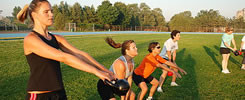Thanks for joining us for the OUTFIT health + fitness 6-week core strength program. This program is a progressive plan, which gradually introduces harder abdominal exercises each week.
I’ve started this program to keep myself honest & work on an area, which certainly isn’t my strength. Like many people I tend to neglect my core training for other activities I prefer. After dislocating my knee & fracturing my hand this month I’m not doing almost any of the exercises I usually love so it’s time to take a step back & build up my core from the basics. Join me!
Core strength vs abdominal strength
While these words are sometimes used interchangeably I want to distinguish the 2. The abdominals are a series of different muscles; the rectus abdominus (responsible for flexion or curling) that give some lucky people a 6-pack look, the obliques responsible for stability & twisting movements  and the very important TA (transverse abdominus), which we’ll work with throughout the program. These abdominal muscles are only a part of ‘the core’. Throughout the body muscles & connective tissue work in synergy to support, facilitate movement & protect the body. The core is a great example of this & an area we need to continue to develop. Abdominal muscle strength & endurance would be measured with a traditional sit-up test. Core strength is much harder to dfine & quantify. It’s best measured with something relevant to your goals or sport. But let’s not et bogged down on that. We’re here to get a stronger core.
and the very important TA (transverse abdominus), which we’ll work with throughout the program. These abdominal muscles are only a part of ‘the core’. Throughout the body muscles & connective tissue work in synergy to support, facilitate movement & protect the body. The core is a great example of this & an area we need to continue to develop. Abdominal muscle strength & endurance would be measured with a traditional sit-up test. Core strength is much harder to dfine & quantify. It’s best measured with something relevant to your goals or sport. But let’s not et bogged down on that. We’re here to get a stronger core.
What is ‘the core’?
The core refers to the physical centre of the body.
Technically it is everything except your head, arms & legs. For the purpose of this program think of the core as the area from the diaphragm, down to the pelvic floor muscles at the bottom of the pelvis, and from the abdominals at the front through to the spine & musculature of the back. It is responsible for; stability of the truck & pelvis allowing movement for the limbs. It is also important in other functions such as breathing, continence & digestion.
It is often described as a cylinder with the lid being the diaphragm, the base being the pelvic floor & the abdominals forming the sides of the cylinder. As the TA muscle runs ‘transversely’ around the body it is a crucial part of this strong cylinder, or core. Being able to activate the TA and other muscle of the trunk will be the key to improving your posture, core strength & athletic performance. I usually do a large portion of my core training as part of other activities; surfing, sprinting, climbing, box jumps, or general ‘play, but unfortunately most of that isn’t possible right now.
Ewan explains “a strong core is the ability to maintain good posture. It is our centre of gravity and is the starting point for movement. A strong core will protect our spine and provide a good foundation for balance, agility, greater power and faster speed.”
We begin Week 1 of the 6-week Core Strength Training Program with the basics. TA activation, general principles of movement of the spine & pelvis and a lot of commentary about the anatomy of the core. I’ve recruited the help of 5 fantastic fitness experts to give their individual take on core strength so we can all benefit.
As this program developed (very quickly) on the back of a conversation on Facebook I asked that those participating (at least the first dozen) to contribute a suitable donation to the those who need it most. Let us know who you support with your healthy actions (& kind donations) so we can feel all warm & fuzzy.
My initial suggestion was to donate to the Salvos, Vinnies or the Smith Family. 3 great charities I respect & admire. As a Triple J listener I’m really impressed by their Jacket off campaign and feel it’s a great cause, but if you have another great charity close to your heart please feel free to donate to them instead.
As I’ve alluded too above I believe understanding more about what you are working will definitely help your fitness training so for more detailed descriptions & anatomy pics I’ve ‘borrowed’ from the world wide web head along to the Abdominals & Core blog post.
Cheers,
Michael




Speak Your Mind